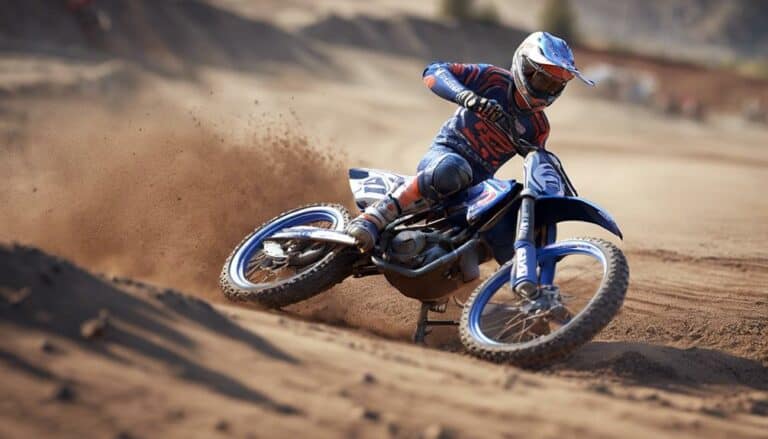When it comes to customizing their suspension setups, professional motocross riders know that 'one size does not fit all.' From adjusting sag percentage to fine-tuning damping settings, these riders meticulously tailor their bikes to conquer diverse tracks and conditions.
But what specific techniques do they employ to achieve such precision and performance? Stay tuned to uncover the secrets behind how these athletes tweak their suspension setups for ultimate control and speed on the ever-changing motocross terrain.
Key Takeaways
- Compression and rebound adjustments optimize traction and handling on diverse tracks.
- Sag settings tailored to weight and riding style enhance control and stability.
- Customized clicker settings refine performance and comfort for various conditions.
- Balancing front and rear suspension improves maneuverability and consistency on different terrains.
Suspension Setup Basics
How can you optimize your motocross suspension setup for peak performance on the track? Professional riders excel by customizing their suspension setups to suit various track conditions and their riding style. To achieve this, it's important to understand the basics of suspension tuning. Compression and rebound adjustments play a critical role in tailoring your suspension to specific terrains. By fine-tuning these settings, you can enhance the way your bike absorbs bumps and maintains traction.
Sag settings are another essential aspect of suspension setup. Professional riders adjust sag to make sure the suspension is optimized for their weight and riding style. This optimization allows for better weight distribution and control over the bike, especially during acceleration, braking, and cornering.
Additionally, adjusting the clickers on your front forks and rear shocks can further refine your suspension setup. These adjustments can improve handling, stability, and overall performance on the track. By mastering these suspension basics, you can elevate your riding experience and compete at the level of professional riders.
Track-Specific Adjustments
When customizing your motocross suspension setup for specific track conditions, professional riders make precise adjustments to optimize performance and control. Riders consider various factors such as the terrain type, track layout, and obstacles present to fine-tune their suspension settings effectively.
Here are some key track-specific adjustments that riders focus on:
- Sag: Setting the correct sag guarantees the suspension is appropriately loaded, enhancing traction and control on different track surfaces.
- Compression Damping: Adjusting compression damping helps riders manage the impact forces on rough terrain, preventing excessive bottoming out and maintaining stability.
- Rebound Settings: Tuning rebound settings is essential for handling jumps and whoops, allowing the suspension to react smoothly to varying terrain features.
- Customization for Track Conditions: Tailoring suspension settings based on track conditions like hard-packed, sandy, or muddy surfaces optimizes performance and control.
- Balancing Traction and Control: Fine-tuning front and rear suspension balance in corners maximizes traction and control, aiding in maneuverability around tight turns.
These track-specific adjustments play a significant role in enhancing a rider's performance and overall riding experience.
Weather and Terrain Considerations
Considering the impact of weather conditions and terrain types, professional motocross riders adjust their suspension setups to optimize performance on varying tracks. When facing different track surfaces, such as hard-packed, sandy, or muddy terrains, riders focus on adapting compression and rebound settings. For hard-packed tracks, stiffer settings help prevent bottoming out and maintain stability over rough sections. In contrast, sandy tracks require softer settings to improve traction and absorb bumps effectively. In muddy conditions, adjusting compression to a middle ground enhances handling while maintaining control over slippery surfaces.
Additionally, weather conditions like temperature and humidity further influence suspension adjustments. In colder temperatures, riders may need to increase compression to compensate for the thicker oil viscosity, ensuring consistent handling. Conversely, in hot and humid conditions, decreasing compression can prevent overheating and maintain optimal suspension performance. By fine-tuning suspension setups based on weather and terrain considerations, professional riders enhance their bikes' handling, stability, and traction, giving them a competitive edge on the track.
Fine-Tuning Techniques
Professional motocross riders finely adjust compression and rebound damping settings to optimize their suspension performance on diverse terrains. When fine-tuning your suspension settings, consider the following techniques:
- Suspension Clickers: Riders customize these to achieve the ideal balance between comfort and control on different tracks.
- Sag Measurements: Adjusting sag helps in adapting the suspension to varying track surfaces and layouts for improved handling.
- Preload and Spring Rates: Customizing these based on rider weight and style guarantees the best suspension response and stability.
- High-Speed Compression: Utilize this adjustment for managing bigger impacts and maintaining stability at high speeds.
- Low-Speed Clicker: Fine-tuning this setting allows for precise control over smaller bumps and enhances traction in different conditions.
Pro Tips for Optimal Performance
To optimize your motocross suspension performance, precise adjustments to compression and rebound damping settings are essential for achieving ideal handling and control on varying track surfaces. By customizing your suspension setup based on track conditions, riding style, and your weight, you can enhance traction and overall handling. Balancing the front and rear suspension is vital for stability and control, making sure that your bike responds effectively to the terrain.
| Suspension Adjustment | Impact |
|---|---|
| Compression Adjustments | Fine-tune for varying track conditions to control how quickly the shock compresses. |
| Rebound Damping | Adjust to regulate how fast the shock extends back to its original position. |
| Clicker Settings | Customize to match your riding style and optimize performance on different terrains. |
| Sag Measurements | Ensure accurate sag measurements to maximize traction and handling. |
Conclusion
You've mastered the art of suspension setup customization for different tracks and conditions. Remember, 'Practice makes perfect.'
Keep fine-tuning your adjustments with precision and attention to detail. Your expertise in optimizing performance, stability, and traction will set you apart on the track.
Keep pushing the limits of your skills and knowledge to achieve maximum control and safety while dominating the competition.

